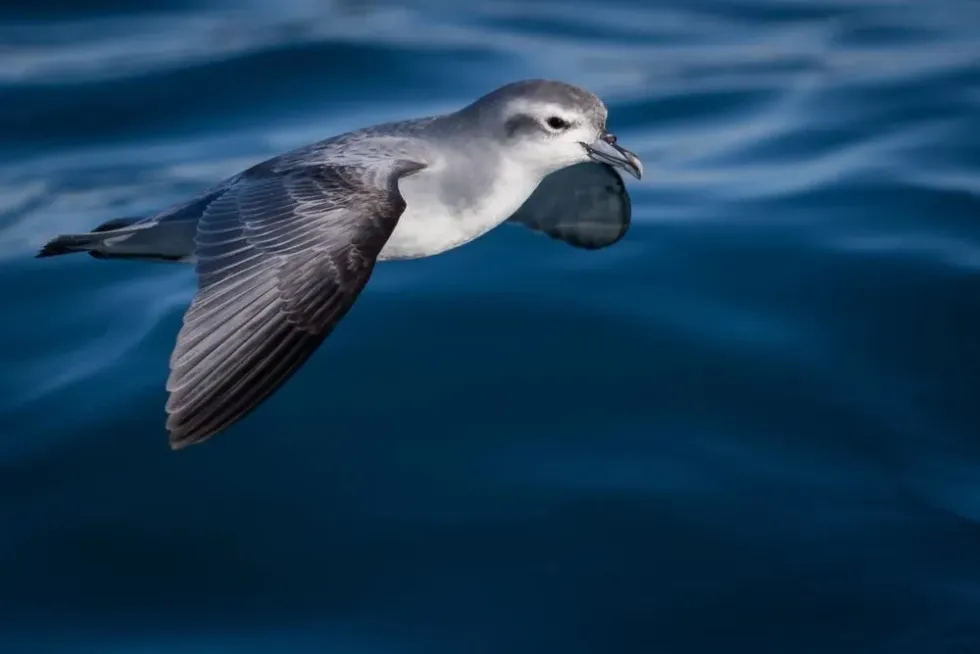Fairy prion (Pachyptila turtur) of the genus Pachyptila is a small-sized seabird that belongs to the Procellariiformes order. This species covers a large range in New Zealand, South Georgia, north Crozet Islands, Falkland Islands, Chatham Islands, and Australia.
It is the smallest prion known in this family and has beautiful bluish-gray hues on the upper parts of its body. The lower part is creamy white in color. Their upper part possesses a dark M-shaped pattern through its wings that enhances their look.
The fairy prion feeds on small pelagic crustaceans, fish, and other types of marine organisms. They inhabit the sea, coastal areas, and islands and reside in colonies.
They breed in burrows or hollow crevices in the soil, dug up by their blue bill and feet. Identification of the Fairy prions can be quite challenging as the fulmar prion and broad-billed prion exhibit similar features throughout.
The Blue Petrels are the closest relative of the fairy prions and can only be distinguished by their larger body size and petrel-shaped bill. Keep on reading to learn more about this intriguing species of prions.
If you liked reading this article, then do check out the blackpoll warbler and red-backed shrike.
Fairy Prion Interesting Facts
What type of animal is a fairy prion?
Fairy prions are seabirds belonging to the Procellariiformes order.
What class of animal does a fairy prion belong to?
The fairy prion, scientific name Pachyptila turtur, belongs to the Ave class and the Pachyptila genus.
How many fairy prions are there in the world?
There are a total of about 5,000,000 fairy prions known to exist in the world. However, this species of billed prion is monotypic and thus, does not have any subspecies. The largest of their species is the broad-billed prion, and their closest relatives are the blue petrels.
Where does a fairy prion live?
The fairy prions' population is seen in New Zealand, South Georgia, north Crozet Islands, Falkland Islands, Chatham Islands, and Australia. This prion bird is migratory in nature, just like the Cape petrel, and thus its family can cover quite a good range like the petrel.
What is a fairy prion's habitat?
The population of these billed prion species resides in coastal areas, islands, and surfaces of oceans.
Who do fairy prions live with?
These species of billed prion live and breed in colonies just like the ring-billed gull and brewer's blackbird.
How long does a fairy prion live?
The lifespan of the fairy prion species of the Pachyptila genus is about 15-20 years.
How do they reproduce?
These billed prion species reproduce by laying eggs. They are known to lay only one egg. They are highly colonial and thus, breed in small groups. Their breeding season initiates in August.
The prions build their own nest, which are new burrows or hollow crests in soil and dug up by their bill. Their incubation period lasts for about 50 days, and both the parents are known to feed and protect the chicks. The diet of the chicks includes food regurgitated by their parents, just like pigeons.
What is their conservation status?
The IUCN Red List (International Union for Conservation of Threatened Species) has listed the fairy prion (Pachyptila turtur) as a species of Least Concern. Though their population trend is stable, increased water pollution and land destruction can impose a threat to these species. The eggs of these birds also have natural predators like cats, rats, and skuas.
Fairy Prion Fun Facts
What do fairy prions look like?
The fairy prion (Pachyptila turtur) is a white-colored seabird with blue-gray hues on the upper parts of its body. They have a characteristic M-shaped sign throughout the wings and the feather on the upper part that looks strikingly beautiful during their flight.
It has broad wings with a white tip, and its bill and feet are bluish-gray in color. They use their bills and feet to dig up burrows in the soil. They have a long tail with a black tip.
How cute are they?
These prion species look extremely cute because of their stunning white body and bluish-gray upper parts. They have a long tail with black ends.
How do they communicate?
The titi wainui (the Maori name for fairy prion) communicates by their harsh vocal calls and can sound like rattles.
How big is a fairy prion?
The fairy prion bird is about 9.1–11 in (23-28 cm) length and is quite bigger than the American yellow warbler, about 3.9-7 in (10-17.7 cm).
How fast can a fairy prion fly?
Though the exact speed of the fairy prion is unknown, other species of prions, like the Antarctic prion, are known to fly at an estimated speed of 35 mph (56.3 kph).
How much does a fairy prion weigh?
These prion species weigh about 0.194-0.392 lb (0.08-0.17 kg).
What are the male and female names of the species?
There are no specific names given to this species' male and female birds of the Procellariiformes order.
What would you call a baby fairy prion?
A baby prion is called a chick.
What do they eat?
Their feeding habits include crustaceans and a number of fish, typically. Their diet also includes small marine animals found on the ocean surface.
Are they dangerous?
This bird species is not dangerous and does not impose any harm on humans.
Would they make a good pet?
Prions are sea birds, and they pray on fish and crustaceans from the ocean surface. Therefore, their habitat involves coastal and marine areas. Thus, these species of birds would not be good pets.
Did you know...
The tuatara and fairy prion breeding walls refer to a classic example of a parasitic relationship. The tuatara parasitizes the burrow of the fairy prions and draws food and nutrition from the birds.
The prion's excreta attracts a large group of insects, which are prayed upon by the tuatara.
The tuatara fairy prion relationship is quite popular, as the tuataras often pray on the prion's eggs. This capability of the tuatara to seek nourishment and protection from the sea bird, fairy prion, serves as the food source for several other reptilian species.
Researchers found that the bills of the New Zealand seabird (fairy prion) are capable of producing a waxy substance that repels the predators and keeps the prions safe. This is called Proventriculus and has a foul odor. This waxy substance also serves as great energy-rich food, and the adult prion includes this while feeding their chicks.
This bird species is known to possess a salt gland just above its nasal cavity. This gland helps it excrete out the excess saline water from its nostrils, which enters into their body while capturing pray from the ocean surfaces.
Their mode of capturing their prey from the pelagic zones attributes to the great sensory ability of fairy prion. The presence of whales is marked by fairy prions. Whales are able to accumulate shoals of fishes that are prayed upon by fairy prion birds.
There are several types of prions like the slender-billed prion, Antarctic prion, broad-billed prion, Fulmar prion, and Salvin's prion, all of which belong to the Procellariidae family.
Why is it also known as fairy prion?
In Greek, the word 'prion' means 'saw', which refers to the saw-edged ends of its bill. The term 'fairy' is a reference to the white feather that covers the body of these prions. These birds are thus called fairy prions.
What's unique about a fairy prion?
Fairy prions are known to be the smallest birds in the prion species, and their body description similarizes to that of the broad-billed prion. These species are known to breed in burrows and possess harsh calls in colonies. These calls are often distressful and quite loud. Their bill is also quite unique and enhances their charm.
Here at Kidadl, we have carefully created lots of interesting family-friendly animal facts for everyone to discover! For more relatable content, check out these bowerbird facts and umbrellabird facts for kids.
You can even occupy yourself at home by coloring in one of our free printable scarlet robin coloring pages.
Second image by Sabine's Sunbird.









